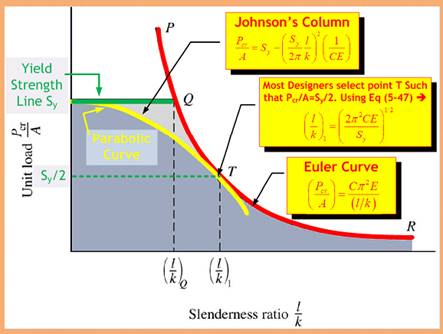4.10 Statically Indeterminate Problems
 To obtain a solution, a deflection equation is required for each redundant support reaction.
To obtain a solution, a deflection equation is required for each redundant support reaction.Shown are three support reactions and only two static equilibrium equations are available.
This beam has one redundant support. To solve for the three unknown support reactions we use the two equilibrium equations and one additional deflection equation.

Shown is a beam that has a wall on both ends, giving rise to two redundant supports requiring two deflection equations in addition to the equations from statics.
Nested helical springs Example:
 When this assembly is loaded by the compressive force F, it deforms through the distance δ. What is the compressive force in each spring?
When this assembly is loaded by the compressive force F, it deforms through the distance δ. What is the compressive force in each spring?
Only one equation of static equilibrium can be written. It is
![]()
Since there are two unknowns and only one static equilibrium equation, the system is statically indeterminate.
Deflection equation is: the two springs have the same deformation.
![]()
Or

Solve for F1 and sub. Into (a), we get

thus ![]()
and 
Thus, for two springs in parallel, the overall spring constant is k = F/δ = k1 + k2 .
Procedure 1
Example 4-14 (see textbook)
Procedure 2 (omit)
Example 4-15 (see textbook) (omit)
4.11 Compression Members—General
 Column – Straight, slender members loaded axially in compression such that either its length or eccentric loading causes it to experience more than pure compression.
Column – Straight, slender members loaded axially in compression such that either its length or eccentric loading causes it to experience more than pure compression. 4.12 Long Columns with Central Loading
4.12 Long Columns with Central Loading


where the constant C depends on the end conditions as shown. In practice it is difficult, if not impossible, to fix the column ends so that values of C apply. Some designers never use a value of C greater than unity. However, if liberal factors of safety are employed, recommendations are summarized in Table shown.


where l/k is called the slenderness ratio, used to classify columns according to length categories.
Pcr /A is the critical unit load, the load per unit area necessary to place the column in a condition of unstable equilibrium, where any slight movement of the support or load, will cause the column to begin to collapse (buckle). This is not a material property.
 Plotting Pcr /A vs l/k, with C = 1 gives the curve PQR shown.
Plotting Pcr /A vs l/k, with C = 1 gives the curve PQR shown.Since the yield strength of the material has the same units as the unit load, the horizontal line through Sy and Q has been added to the figure.

For (l/k) > (l/k)1, use Euler equation
For (l/k) ≤ (l/k)1, use a parabolic curve between Sy and T
4.13 Intermediate-Length Columns with Central Loading



 4.14 Columns with Eccentric Loading
4.14 Columns with Eccentric Loading
M = - P (e + y)







 Figure shown is a plot of Eq. (4–50) for steel having compressive (and tensile) yield strength of 40 kpsi. Note how the P/A contours asymptotically approach the Euler curve as l/k increases.
Figure shown is a plot of Eq. (4–50) for steel having compressive (and tensile) yield strength of 40 kpsi. Note how the P/A contours asymptotically approach the Euler curve as l/k increases.
Examples 4-16 to 4-19 (see textbook)
Euler Equation (4.44) for round cross sections:

Euler Equation (4.44) for rectangular cross sections:

J. B. Johnson Equation (4.46) for round cross sections:

J. B. Johnson Equation (4.46) for rectangular cross sections:

 4.15 Struts or Short Compression Members (omit)
4.15 Struts or Short Compression Members (omit)

where k = (I/A)1/2 which is the radius of gyration, c is the coordinate of point B, and e is the eccentricity of loading.

This equation then gives the limiting slenderness ratio for using Eq. (4–55).
If the actual slenderness ratio is greater than (l/k)2, then use the secant formula; otherwise, use Eq. (4–55).
Examples 4-20 (see textbook) (omit)


Source: http://site.iugaza.edu.ps/jelzebda/files/2013/03/0-Chapter-04-part-B1.doc
Web site to visit: http://site.iugaza.edu.ps
Author of the text: indicated on the source document of the above text
If you are the author of the text above and you not agree to share your knowledge for teaching, research, scholarship (for fair use as indicated in the United States copyrigh low) please send us an e-mail and we will remove your text quickly. Fair use is a limitation and exception to the exclusive right granted by copyright law to the author of a creative work. In United States copyright law, fair use is a doctrine that permits limited use of copyrighted material without acquiring permission from the rights holders. Examples of fair use include commentary, search engines, criticism, news reporting, research, teaching, library archiving and scholarship. It provides for the legal, unlicensed citation or incorporation of copyrighted material in another author's work under a four-factor balancing test. (source: http://en.wikipedia.org/wiki/Fair_use)
The information of medicine and health contained in the site are of a general nature and purpose which is purely informative and for this reason may not replace in any case, the council of a doctor or a qualified entity legally to the profession.
The texts are the property of their respective authors and we thank them for giving us the opportunity to share for free to students, teachers and users of the Web their texts will used only for illustrative educational and scientific purposes only.
All the information in our site are given for nonprofit educational purposes